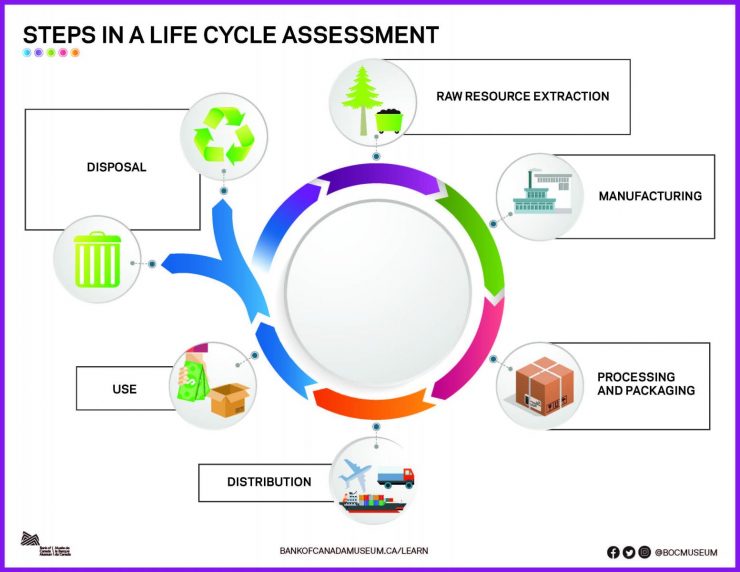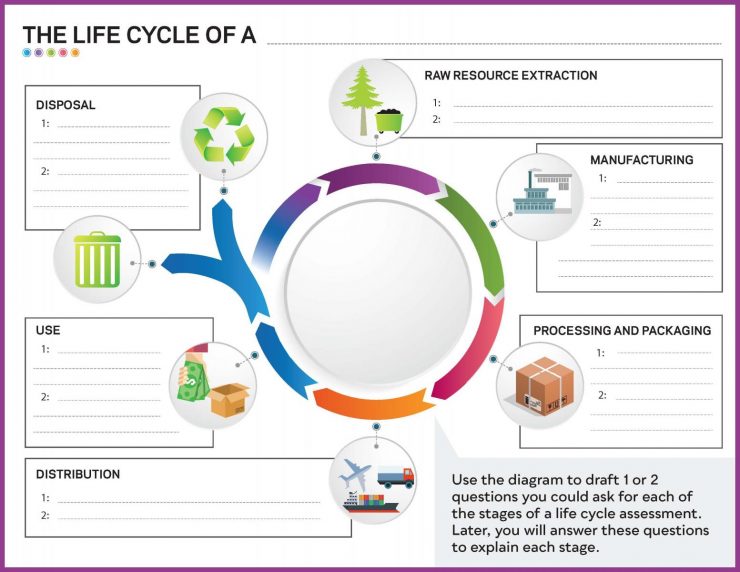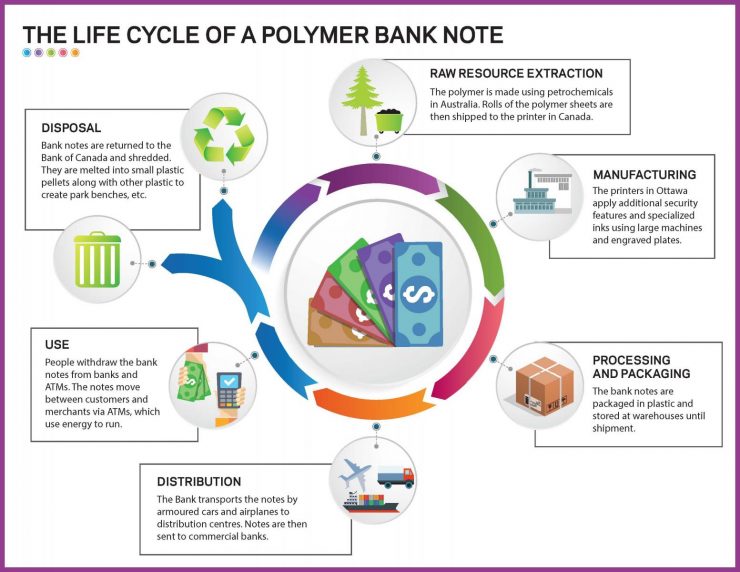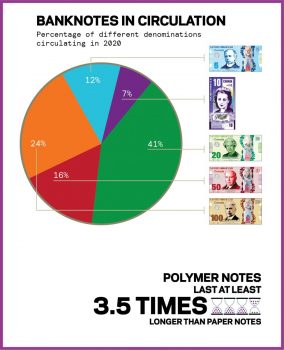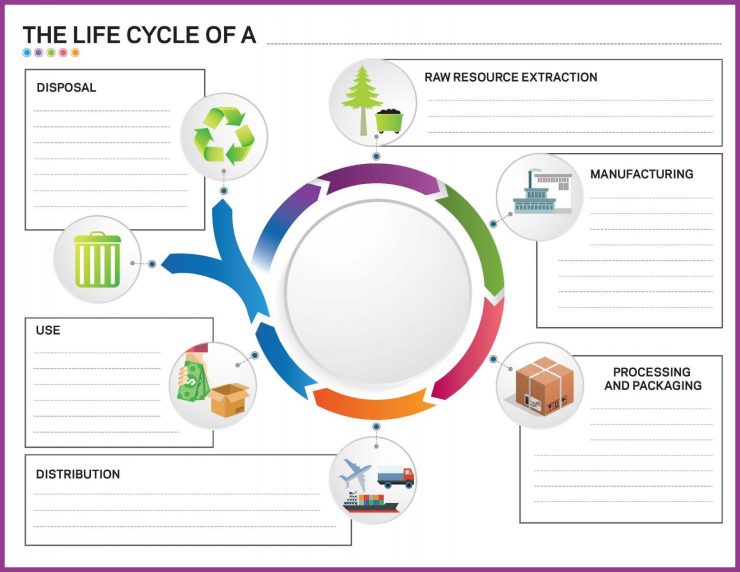
Examine the environmental impact of everyday items by assessing the life cycle of a universal product: money.
Overview
The Bank of Canada’s switch from paper to polymer bank notes is an excellent case to study product decisions that require a life cycle assessment (LCA). Using bank notes as an example, students will explore the stages of a product’s life cycle, going “under the hood” to determine the environmental, social and economic impacts of its manufacture, use and disposal. Next, they will research a product of their choice using the same LCA process, considering the impacts of each stage of the life cycle, such as manufacturing and use.
Big idea
Life cycle thinking considers the full impact of what we produce as a society as well as efficiencies and greener options.
Total time
Approximately 60 minutes of instruction time, plus more for the research project
Grade levels
Grades 5 to 10; Elementary Cycle Three to Secondary IV
Subject areas
Geography
- environmental, social and economic impacts of consumption
- long-term human impacts of resource and energy use on the environment
- the role and effects of technologies on energy consumption
- areas of energy efficiency and conservation
Science and technology
- immediate and long-term effects of energy and natural resource use on the environment
- environmental impact of a product and the resources required throughout its life cycle
- areas of energy and resource efficiency, transformation and conservation
Learning objectives
Students will:
- investigate the environmental, social and economic impacts of the life cycle of commonly used products
- develop skills for thinking about systems to understand the relationships between human consumption and the environment
- conduct a life cycle assessment using research, and present findings to the class
- evaluate the impact of making greener choices
Materials
Classroom supplies and technology
- printer and paper
- pens or pencils
- whiteboard or chart paper and markers
- projector or display screen hooked up to a computer (optional)
- internet-equipped devices
Worksheets
Download and print these resources on regular paper:
- “Life Cycle of a _____” worksheet — two copies per student
- “The Life Cycle of a Polymer Bank Note” diagram — print or display to review together
Activity 1: Research the life cycle of bank notes
Students will compare paper and polymer bank notes. They will then learn about the stages of a polymer note’s life cycle and conduct an LCA on this product.
Time
30 minutes
1.1 Opening discussion: Examine both sides—paper or polymer?
Begin the class by asking students to think about their last few purchases. What kinds of things do they consider when they are buying something? After sharing and reviewing some responses, ask if anyone considered a product’s environmental impact. Then provide students with an overview of today’s lesson. They will be learning about the environmental, social and economic impacts of everyday products and thinking about ways to make those products less energy- and resource-intensive.
Explain that a life cycle assessment, or LCA for short, looks at a product from “cradle to grave,” just like we think of the life cycle of a living thing, from its birth to death and everything in between. An LCA looks at the impact that a product has during different stages of its existence.
Offer the example of a bank note to introduce the LCA process. Explain that around 1.5 billion Canadian bank notes are presently in circulation. Because money is used by nearly everyone in society, it’s a great example of a common product to study.
If time allows, you may want to show an example of both a current polymer bank note and an old paper one using a projector and screen. Have students examine both sides, then divide the class into pairs or small groups to discuss paper versus polymer bank notes. Ask students to think about the pros and cons of each type of material, taking notes if they would like.
If helpful, provide some example perspectives and topics to consider. These may include:
- What are the environmental impacts of making bank notes from paper and from polymer?
- How easy or difficult is it for people with disabilities to use paper and polymer notes?
- How do banks and automated teller machines (ATMs) distribute paper and polymer notes?
- How durable are paper and polymer notes?
After a few minutes, come back together as a class and have the pairs or small groups share their discussion points. Record their thoughts on the board.
1.2 Learn the stages of a life cycle assessment
Explain to students that they will be looking at the polymer bank note in more detail to further understand how a product is made and what the total impact of that product is throughout its life cycle. The Bank of Canada conducted an LCA to determine whether polymer bank notes were a better choice than the previous paper bank notes. Other companies and organizations use LCAs regularly to make their products more efficient, and often to comply with environmental regulations, such as responsible recycling.
Ask students to call out their guesses of the six main stages they think are part of an LCA. Refer to the diagram below to confirm correct responses and provide hints. You may want to draw this diagram on a whiteboard to help students think about the missing steps, or simply display it afterward on a screen.
Next, read aloud the following background information:
In 1988, Australia became the first country in the world to switch to polymer bank notes. Since then, over two dozen countries have done the same, including Canada in 2011. Importantly, using a polymer gives the Bank of Canada more opportunities to embed security features and makes it harder to counterfeit our bank notes. It’s hard to recreate a polymer base, called a substrate, unless you have highly technical skills and manufacturing abilities.
1.3 Brainstorm life cycle assessment questions
Hand out the worksheet “The life cycle of a ___” version for questions.” Ask students to form small groups to draft specific questions about the different stages of a polymer bank note’s life cycle.
For example:
- Under Manufacturing, students might ask “Where is the polymer made?”
- Under Use, they might ask “How do bank notes move from person to person during their lifespan” or “What bank notes are most commonly used?”
Ask the whole class or walk around to small groups and ask students if they have any logical answers or guesses. Encourage students to note them as they discuss.
Return together as a class and record the students’ questions on the whiteboard. Review these questions after watching the video clip below.
1.4 Discuss the life cycle of polymer bank notes
Watch the short video "The Life of a Polymer Bank Note." Check whether any of the class’s questions were answered in the video. Then, review the facts in the Appendix or the following diagram:
Ask your students these questions:
- What steps in the life cycle of a bank note do you think would use the most energy? What steps would use the least?
- What types of processes (such as transportation, electricity use, etc.) do you think require energy and natural resources?
- What other impacts might an LCA consider in the later stages of the bank note’s life cycle? These are called downstream impacts.
Point out that the most energy-intensive part of a bank note’s life is during its use. While it is hard to estimate how far bank notes travel, we can get a sense of the electricity used to store them in ATMs. This electricity accounts for a large amount of the total emissions of a bank note.
1.5 Discuss additional impacts and measurements
An LCA focusses on the impact of a product on land, water, energy, the environment and labour. If time allows, older grades could explore more of the categories that an LCA would usually consider, such as:
- Fossil fuel and metal or mineral depletion—the amount of a metal or fossil fuel required compared with its global supply and availability
- Water requirements—the water needed for processes such as machine and factory heating and cooling, separating minerals and chemicals, and water baths for cleaning and cooling components
- Climate change impacts on human health and natural ecosystems—how the level of greenhouse gas emissions (or CO2 equivalents) affects the stages of life and possible subsequent climate change impacts, such as habitat loss, extreme heat, flooding, etc.
- Particulate matter formation—gasses and liquids developed during industrial processes that could affect the environment, such as through acidification and the formation of smog
- Human toxicity—the level of toxicity or health impacts caused by the metals and chemicals used in manufacturing and disposal. This could include leaching of these toxins into the ground, groundwater or water systems, causing eutrophication, a buildup of nutrients.
- Agricultural land occupation—use of land for human purposes such as farming, ranching, forestry or buildings
Activity 2: Research the life cycle of another product
In this activity, students will use their knowledge and inquiry questions to conduct a life cycle assessment of a product of their choice.
Time
15 minutes for instruction, additional time for research project
2.1 Discuss energy-intensive and resource-intensive stages
To recall the different energy- and resource-intensive stages of a product’s life cycle, quiz your students on the following three products. Can they guess the most intensive stage? Reveal the answers after each product has been discussed.
- What is the most resource-intensive stage of a cell phone’s life? Answer: the use stage—cell phones and other common electronics require a lot of electricity. They are plugged in constantly, even when not needed.
- What is the most resource-intensive stage of a cotton t-shirt’s life? Answer: the use stage—it takes a lot of water, energy and detergents to wash and dry this piece of clothing.
- What is the most resource-intensive stage of a hammer’s life? Answer: the manufacturing stage—metal requires a great deal of energy and resources to be refined, melted and moulded. The use and distribution stages of this and many other metal products require much less energy than that needed to manufacture them.
Sum up the key principles of an LCA by asking your students the following discussion questions:
- What are some challenges in doing an LCA? (For example, some standards might be hard to measure; it’s costly to assess each step and track adequate supply and use chains beyond energy and resource use.)
- How do you assess a product in relation to the resources it uses? For example, how do you account for a machine’s impact if it is used to manufacture many different products?
- What types of green or lower-impact technologies and solutions do you think could be used at different stages of a product’s life cycle? (Examples include using fewer natural resources or using recycled resources for raw manufacturing, using renewable energy in manufacturing, or reducing packaging.)
- What steps in the design process would help make products more sustainable? (Examples include designing to make things easy to take apart (disassembly) and the parts easy to reuse (de-materialization) and to make things last longer (longevity).
2.2 Create your own life cycle assessment
Prepare your students to conduct their own LCA individually or in pairs. Have them choose a product to research to discover its environmental, social, and economic impacts. Then, give each student or pair another blank “The life cycle of a ___” worksheet and have them think of research questions for each stage of their product’s life cycle. These questions will help frame their research. Remind them that some of their questions may be similar to or the same as the ones in the bank note LCA.
Provide time and internet-equipped devices for students to complete their research on their questions. Ask them to jot down bullet notes directly on the blank worksheet. Allow time in the next class to complete their LCAs and present or share them in small groups or to the whole class.
Conclusion
Time
15 minutes
To close the lesson and check for understanding, ask your students the following questions:
- What makes an LCA challenging?
- Based on what you have learned about LCAs, what kinds of questions should you ask as a conscious consumer when you are thinking about buying or using something?
- How might a company use the language of a life cycle assessment to make a product sound more environmentally friendly than it actually is?
- How might a company use an LCA to improve its product?
- What power do you have as a consumer to change business practices and make them more environmentally friendly?
Key takeaways
- A life cycle assessment is a useful tool for better understanding some of the many ways that humans affect the natural world.
- Sometimes the most environmentally friendly option may not be the most obvious. Looking at the whole life cycle of a product helps us to think critically about our consumer choices.
- Different stages of a product’s life can have very different environmental, social and economic impacts.
- Using data can help us make greener decisions that could reduce our footprint on the planet.
Extensions
- Have your students debate the environmental impacts of physical money versus e-money. Consider factors such as the use of servers to store information and the energy requirements of technology such as a cell phone or plastic debit card manufacturing. Which format of money do they think is more environmentally friendly?
- Using a similar analysis, discuss with your students an LCA of a penny. What different environmental, social and economic impacts might the Mint have researched when deciding to retire the one-cent coin?
- Explore with your class the ethical issues and labour practices that a life cycle assessment could expose. Where do people and especially workers fit in the picture of manufacturing and recycling different goods?
- As a class, create an awareness event or campaign to inform others in the school about the life cycle assessment of different items that are popular in your school. Show your peers the true environmental, social and economic impact of those items. Help them make informed choices about their own environmental footprints.
Appendix: Facts on the life cycle of bank notes
The Bank of Canada is responsible for nearly every stage of a bank note’s life cycle, from research and design to manufacturing, distribution, returning, sorting and disposal. However, the Bank is not responsible for the raw resource extraction and how or where the notes are used in society.
While demand for physical cash may vary from month to month, $200 million to $240 million worth of bank notes are printed for the Bank of Canada each year. That’s nearly $6 billion in value over the last 20 years.
Here are some facts about Canada’s polymer bank notes.
Raw material and manufacturing
- The companies that sell security printing supplies are based all over the world, and the polymer that Canada uses for its bank notes comes all the way from Australia. The materials are shipped to Ottawa, Ontario, and the bank notes are printed by Canadian Bank Note Company, Ltd.
- In 2020, the Ontario manufacturing site used a mix of 57 percent nuclear energy, 24 percent hydroelectricity, 9 percent wind energy, 6 percent gas, and the rest was biofuel and solar.
- The volume of ink used in a year varies, depending on how many notes we need to print. If we printed about 200 million notes in a year, we would use 14,000 kilograms of ink to create the raised-ink security feature of bank notes.
- Polymer notes weigh about 10 percent less than the older paper notes.
Packaging
- Once the Bank of Canada inspects the notes for quality, it packages them in plastic and sends them to its Agency Operations Centres for storage. Eventually, the Bank distributes the notes to financial institutions across Canada.
Daily use and distribution
- Early research on polymer bank notes suggested that they would last at least 2.5 times longer than paper notes. That number can actually increase to more than 3.5 times longer, depending on how often each denomination is used (higher-denomination bills do not move through the system as much, so they last much longer).
- At the end of 2020, approximately 2.6 billion bank notes were in circulation. This includes all denominations of the current series ($5, $10, $20, $50 and $100) as well as older bank notes that are no longer issued.
- The most commonly used bank note is the $20 bill.
- Although manufacturing polymer bank notes initially requires more energy than manufacturing paper notes, polymer notes still use 30 percent less energy overall. This is because they don’t need to be replaced as often as paper notes. One print run of polymer bank notes has the same lifespan as three print runs of paper notes.
- Surprisingly, bank notes use a lot of energy over the course of their life cycle. The most energy-intensive step is storage in automated teller machines, which use a lot of electricity.
- Bank notes are initially distributed by armoured cars and planes but then also move around the country from person to person. This means they can travel much more widely than other consumer products. The Bank of Canada cannot measure the impact of these movements.
Disposal
- Bank notes are removed from circulation when they are no longer fit to be used. This includes if they become torn or damaged. They are collected by financial institutions such as your local bank and eventually given back to the Bank of Canada.
- The Bank shreds unfit polymer bank notes at its cash processing centres. A contracted company then recycles the notes completely by melting them to create pellets. The pellets can be used to create common plastic items such as lawn furniture. Unlike other recycling products that can be re-processed into the same product (a closed loop), the pellets made from recycled bank notes cannot be used to make new bank notes (an open loop).
- Paper notes cannot be recycled due to their high quantities of ink and their foil marks. Unfit paper notes are shredded and sent to a landfill, where they emit greenhouse gases as they decompose.
We want to hear from you
Comment or suggestion? Fill out this form.
Questions? Send us an email.
